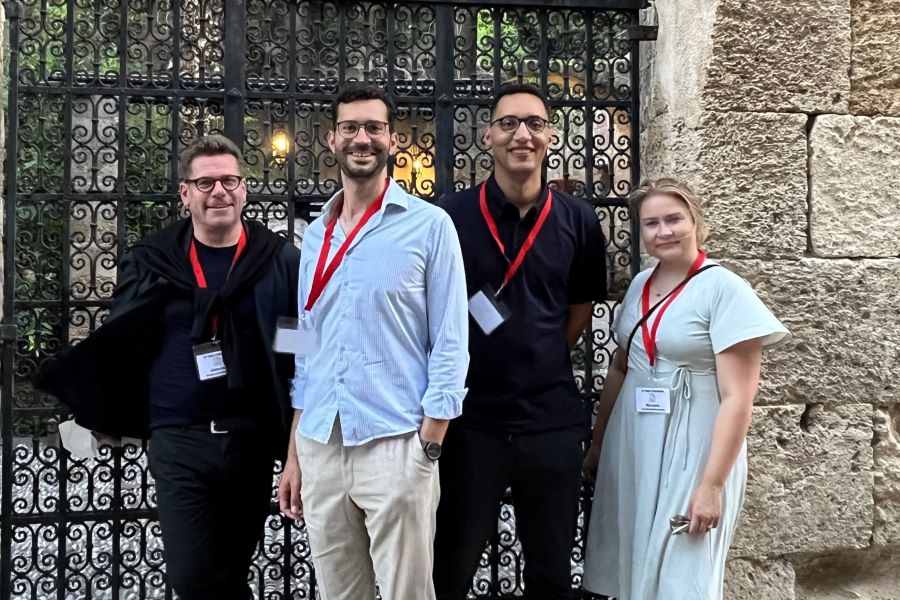How can urgency be constructed in protracted crises? - Study examines COVID-19 pandemic
Despite the increasing awareness of large-scale crises, the understanding of how organisations construct urgency during protracted crises remains limited. In their latest study, published in the Journal of Management Studies, the Viadrina economists Dr Lorenzo Skade, Elisa Lehrer, Dr Yanis Hamdali and Prof. Dr Jochen Koch examine the activities of the Robert Koch Institute (RKI) during the COVID-19 pandemic. Their findings emphasise the complex nature of urgency, its construction through temporal practices and contribute to a deeper understanding of crisis management. Here the team reports on their findings. The original text was published on the Management Studies Insights blog.
Urgency in crisis management: a critical aspect
As we know from the existing literature, urgency is crucial for successful crisis management. Organisations need to respond in a timely manner to mitigate and prevent (potential) damage that can result from a crisis. Traditional crisis management research often focuses on short-lived crises, where the need for urgent action is often obvious. However, protracted crises such as the COVID-19 pandemic pose different challenges for organisations. Such crises require a sustained state of perceived urgency among stakeholders over extended periods of time. It is therefore essential to understand how organisations effectively construct and modulate urgency over a long period of time in order to manage these types of crises (for example, the climate crisis).

privat
Case study: Robert Koch Institute (RKI)
The RKI played a key role in managing and communicating public health measures and conveying the urgency of the pandemic to the German public and policy makers. For our analysis, we relied on 45 hours of video recordings of the institute's press conferences, 371 of its daily situation reports and more than 645 external documents, most of which include media coverage of the RKI's actions.
Urgency in protracted crises: A temporal perspective
From a temporal perspective, we analysed how the RKI translates temporal cues of the crisis into different forms of urgency. To illustrate this, we developed a process model and highlighted three modes of urgency construction and modulation of the RKI:
1. Early mode: first perception
In the early stages of the pandemic, the RKI recognised the emerging threat of the virus. However, the organisation did not immediately start constructing urgency. This phase was characterised by the translation of temporal cues, such as initial infection rates, without taking drastic measures. The initial press conferences tended to call for cautious composure and the risk to the German population was assessed from low to moderate.
2. Escalation mode: increasing the urgency
The RKI switched to escalation mode as the pandemic progressed. Temporal cues were translated into materialised temporality, such as the reproduction value (R-value) and daily case numbers. These served as benchmarks for understanding and communicating the severity of the crisis. The RKI emphasised the need for immediate action and called on the public to "flatten the curve" by adhering to the strict measures.
3. Pause mode: reducing the urgency
Interestingly, the RKI reduced the urgency when the situation seemed to be under control. In this phase, temporal cues were used to signal stability and control. For example, the RKI reduced the frequency of their press conferences during the low case phases, but still urged the public to remain cooperative.
Different forms of urgency
We also identified three forms of urgency used by the RKI:
Windows of opportunity were used to encourage rapid responses from the public and government when immediate action was deemed necessary. One example is the emphasis on the need for continued vigilance and to implement certain measures "as of now".
Inceptive urgency was used to sustain efforts even when immediate threats appeared to be contained.
Expired urgency was used to emphasise missed opportunities for action. It served as a reminder to the population and emphasised the importance of timely response if required.
Implications for crisis management
Our research emphasises the importance of a dynamic approach to managing urgency in protracted crises. A key issue for managers and policy makers is the need to balance escalation and pause phases to effectively manage urgency during protracted crises. This requires crisis management to regularly assess and translate crisis signals to create key indicators, adjust or abolish old indicators and thus enable dynamic crisis responses by modulating urgency. This balance promotes better responses to the changing demands of protracted crises. These insights are not only relevant for pandemic response, but also for the management of long-lasting crisis issues inside and outside organisations (e.g. climate change, financial crises, humanitarian aid and disaster relief).
Text by:
Dr. Lorenzo Skade, research associate (postdoc) at the European University Viadrina, researches theories of time and temporality, strategic practices and process-orientated qualitative methods
Elisa Lehrer, PhD student at the Viadrina, investigates strategic communication and practices, multimodal communication and works methodically with qualitative video analyses
Dr Yanis Hamdali is a postdoctoral researcher at the Viadrina. He works on temporality with a special focus on innovation and shaping the future
Prof. Dr. Jochen Koch holds the Professorship for Management and Organisation at the European University Viadrina. He studies strategic practices and heuristics, strategic communication as well as organisational and entrepreneurial creativity.
Translated by Deepl and edited
Back to the news portal
Share article: